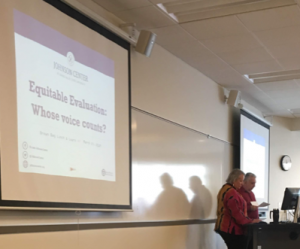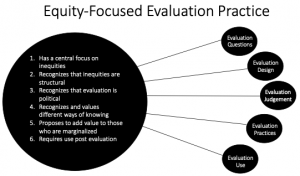Does your evaluation process accurately represent the population you serve? The marginalized and less privileged? We shared in this blog that an equitable evaluation is a process that helps organizations determine if the change that they set to accomplish actually occurred. We follow a 4-step evaluation process: (1) establish clear outcomes, (2) create or modify data tools and systems, (3) analyze the data, and (4) use data to make informed decisions.
In all our work with clients, we want to ensure we’re best representing all populations when doing evaluation. That’s why we’re learning more about an emerging initiative that is transforming the way evaluators think about their work – equitable evaluation.
At TCG, we’re always learning! We recently attended a lunch and learn titled “Equitable Evaluation: Whose Voice Counts?!” hosted by the Dorothy A. Johnson Center for Philanthropy at Grand Valley State University. The presenter  shared examples about how equity is undermined based on traditional evaluation practices. She then shared an overview of the core equitable evaluation principles. The work of evaluation is for and contributes to equity. Evaluations should answer critical questions about the effect of a program on populations, underlying drivers of inequity, and why history and culture might be affecting the work and potential changes. In addition, evaluation design and follow-through should be based around the values of equity, meaning multi-culturally valid and set toward participant ownership.
shared examples about how equity is undermined based on traditional evaluation practices. She then shared an overview of the core equitable evaluation principles. The work of evaluation is for and contributes to equity. Evaluations should answer critical questions about the effect of a program on populations, underlying drivers of inequity, and why history and culture might be affecting the work and potential changes. In addition, evaluation design and follow-through should be based around the values of equity, meaning multi-culturally valid and set toward participant ownership.
We [the audience] were challenged to explore the opportunities to implement equitable practices into our own evaluation work, so that’s what we [TCG] did!
This presentation got us intentionally thinking about our four-step process, how equity is included and opportunities for improvements.
Putting Equitable Evaluation into Practice
Equity can be applied throughout our four steps, creating a fair and impartial process from beginning to end. Some examples for before, during, and after an evaluation that help lead to an equitable evaluation include: 
- Before the evaluation, ensure the program evaluation questions and design are equitable. This means that the evaluation is multi-culturally valid and geared towards participant ownership.
- This thought process can be carried on throughout your evaluation. During the evaluation process, consider equity when determining appropriate stakeholders and the method of collecting feedback from those stakeholders. What factors should be considered for different stakeholders (environment, demographics, politics, influences, etc.)? What methods will be most effective to gather feedback? What influencers may be impacting stakeholder responses, or lack thereof?
- After, review the feedback from the evaluation through a lens of equity. What and/ or who was missing from the process? Determine the next steps to follow through based on the results of the evaluation.
How are you ensuring equitable evaluation in your practice? You can learn more about the Equitable Evaluation Initiative on the EEI website. If you’re stuck in your evaluation process or don’t feel like you have a system in place to effectively collect equitable data – let’s chat!

